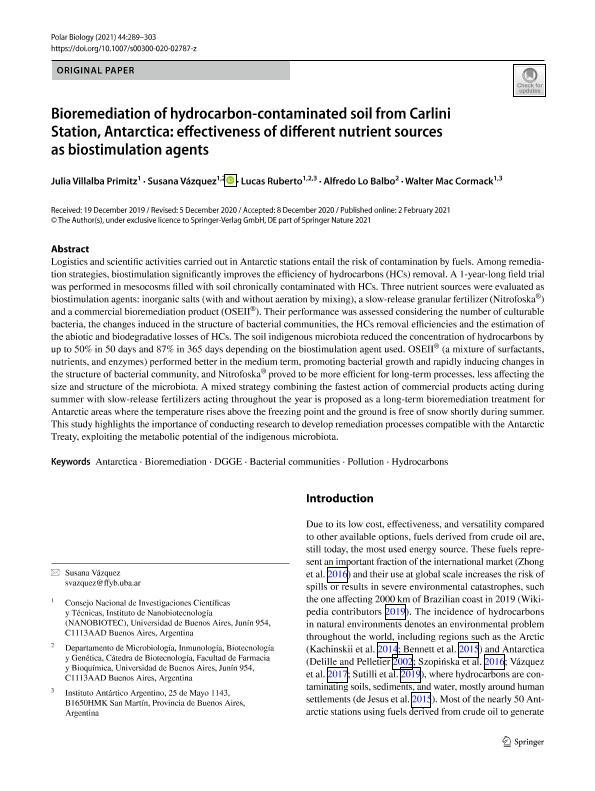Artículo
Bioremediation of hydrocarbon-contaminated soil from Carlini Station, Antarctica: effectiveness of different nutrient sources as biostimulation agents
Villalba Primitz, Julia Elena Rosina ; Vázquez, Susana Claudia
; Vázquez, Susana Claudia ; Ruberto, Lucas Adolfo Mauro
; Ruberto, Lucas Adolfo Mauro ; Lo Balbo, Alfredo; Mac Cormack, Walter Patricio
; Lo Balbo, Alfredo; Mac Cormack, Walter Patricio
 ; Vázquez, Susana Claudia
; Vázquez, Susana Claudia ; Ruberto, Lucas Adolfo Mauro
; Ruberto, Lucas Adolfo Mauro ; Lo Balbo, Alfredo; Mac Cormack, Walter Patricio
; Lo Balbo, Alfredo; Mac Cormack, Walter Patricio
Fecha de publicación:
02/2021
Editorial:
Springer
Revista:
Polar Biology
ISSN:
0722-4060
Idioma:
Inglés
Tipo de recurso:
Artículo publicado
Clasificación temática:
Resumen
Logistics and scientific activities carried out in Antarctic stations entail the risk of contamination by fuels. Among remediation strategies, biostimulation significantly improves the efficiency of hydrocarbons (HCs) removal. A 1-year-long field trial was performed in mesocosms filled with soil chronically contaminated with HCs. Three nutrient sources were evaluated as biostimulation agents: inorganic salts (with and without aeration by mixing), a slow-release granular fertilizer (Nitrofoska®) and a commercial bioremediation product (OSEII®). Their performance was assessed considering the number of culturable bacteria, the changes induced in the structure of bacterial communities, the HCs removal efficiencies and the estimation of the abiotic and biodegradative losses of HCs. The soil indigenous microbiota reduced the concentration of hydrocarbons by up to 50% in 50 days and 87% in 365 days depending on the biostimulation agent used. OSEII® (a mixture of surfactants, nutrients, and enzymes) performed better in the medium term, promoting bacterial growth and rapidly inducing changes in the structure of bacterial community, and Nitrofoska® proved to be more efficient for long-term processes, less affecting the size and structure of the microbiota. A mixed strategy combining the fastest action of commercial products acting during summer with slow-release fertilizers acting throughout the year is proposed as a long-term bioremediation treatment for Antarctic areas where the temperature rises above the freezing point and the ground is free of snow shortly during summer. This study highlights the importance of conducting research to develop remediation processes compatible with the Antarctic Treaty, exploiting the metabolic potential of the indigenous microbiota.
Palabras clave:
ANTARCTICA
,
BACTERIAL COMMUNITIES
,
BIOREMEDIATION
,
DGGE
,
HYDROCARBONS
,
POLLUTION
Archivos asociados
Licencia
Identificadores
Colecciones
Articulos(NANOBIOTEC)
Articulos de INSTITUTO DE NANOBIOTECNOLOGIA
Articulos de INSTITUTO DE NANOBIOTECNOLOGIA
Citación
Villalba Primitz, Julia Elena Rosina; Vázquez, Susana Claudia; Ruberto, Lucas Adolfo Mauro; Lo Balbo, Alfredo; Mac Cormack, Walter Patricio; Bioremediation of hydrocarbon-contaminated soil from Carlini Station, Antarctica: effectiveness of different nutrient sources as biostimulation agents; Springer; Polar Biology; 44; 2; 2-2021; 289-303
Compartir
Altmétricas



